
Carl Sagan and Voyager
In researching the various aspects of this theory, I came across an interesting passage in a book the late Carl Sagan co-wrote with his wife Ann Druyan, entitled “Comet” (1). During their discussion of periodic extinction's on Earth, and whether this could find an astronomical causality, they touched upon the idea of the dark star, a body they termed ‘the Death Star’. Their book was first published in 1985:
“Most of the
stars in the sky are members of double or multiple star systems.
In a typical binary system, two stars separated by several Astronomical
Units are doing a stately gravitational fandango. Often the stars
are more widely separated. In some instances we see two stars gravitationally
bound to each other, but separated by 10,000A.U. At least 15 percent
of the stars in the sky seem to have a companion star at this distance.
The nearest star system to the Sun- Alpha Centauri, 4.3 light-years away- is a double star with a third sun, a distant dim companion called Proxima Centauri, at 10,000A.U. from the two bright stars. Often the companion star is very faint, suggesting that there may be many still undiscovered widely separated binaries. It is possible that most of the stars in the Galaxy are so dim that astronomers call them brown or black dwarfs. Most distant companions might be of this sort.
The solar system seems to be an exception. We do not know of any companion to the Sun. But if we were not an exception, if the Sun had an invisible star in a very specific orbit, then the extinction clockwork again might be understood.” (1)
Sagan and Druyan then go on to describe how such an ‘invisible’ star could have an elliptical orbit that occasionally jostles the comets in the Oort cloud and sends a deadly shower of comets our way. Their notional brown dwarf orbits ellipsoidally at about 1.4 light-years, coming to a perihelion position of 10,000 astronomical units. More interestingly, they go on to consider how the brown dwarf could be the basis of ‘primitive’ mythology, creating a myth of a Dark Sister for the Sun.

Carl Sagan appears to have considered the Dark Star theory in 1985, when I was still at school! Yet, as we have seen, this subject is derided as highly speculative nonsense. Sagan’s reputation and skill as a communicator of scientific knowledge is second to none. He did enjoy speculation as well, and it only ever served to enhance his position in the eye of the public. He was willing to say what other only thought, and he is greatly missed.
He defended his inclusion of this material in this way:
“An invisible sun attacking the Earth with comets sounds like delusion or, at best, myth. But the theory is serious and respectable, if highly speculative, science, because the principal idea is testable: You find the star and examine its orbital properties.” (1)
I could not agree more. Speculation about Planet X, or a brown dwarf in the Oort cloud, and its connection with ancient myth, is a testable hypothesis and should be considered scientific. Unfortunately, in mainstream science, it is generally not thought of in this way. Dr Sagan was ahead of his time, no doubt about that.
Voyager
Voyager 1 was sent on its way in 1977, the year after Sitchin’s first book, the 12th Planet came out. It enjoyed a spectacularly successful tour of the outer planets before heading into the Kuiper Belt and beyond. Interestingly, although it travelled through the plane of the ecliptic to rendezvous with the various outer planets, it did not continue in this vein as it left the planetary solar system. It was sling-shot off the plane, to rise at an inclination to the ecliptic in the direction of the constellation Ophiuchus. Similarly, Voyager 2 underwent a similar, inexplicable sling-shot action off the plane of the ecliptic.
The Voyager Mission home-page gives details of its destination, albeit falling short of actually telling us of its stellar destination:
“The VIM is an
extension of the Voyager primary mission that was completed in 1989 with
the close flyby of Neptune by the Voyager 2 spacecraft. Neptune was the
final outer planet visited by a Voyager spacecraft. Voyager 1 completed
its planned close flybys of the Jupiter and Saturn planetary systems while
Voyager 2, in addition to its own close flybys of Jupiter and Saturn, completed
close flybys of the remaining two gas giants, Uranus and Neptune.
Voyager 1 is escaping the solar system at a
speed of about 3.5 AU per year, 35 degrees out of the ecliptic plane to the
north, in the general direction of the Solar Apex (the direction of the Sun's
motion relative to nearby stars). Voyager 2 is also
escaping the solar system at a speed of about 3.1 AU per year, 48 degrees out of
the ecliptic plane to the south.” (2)
Why sling-shot it out at 35 degrees to the ecliptic? After all, it is well known that Pioneer 10 is heading towards Taurus, in the plane of the ecliptic. The final trajectory of these probes to the outer planets was surely not a random, unplanned event. The Voyager probes had been successfully manoeuvred around other planets in the solar system in such a way that they would be accurately set on course for the outer planets. So the final leg of their journeys were surely not in the ‘lap of the gods’, but were similarly executed with some prior knowledge.
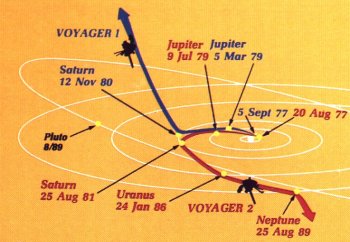
Of the four probes sent beyond Neptune, the two Pioneer craft, 10 and 11, maintained trajectories along the plane of the ecliptic.
Voyager 1 escaped the planets to the north,
Voyager 2 to the south. This implies the
anticipation of future discoveries of
new planetary bodies beyond Neptune. Spreading the net wide, as it were,
would enable the mission scientists to triangulate the location of a massive
perturbing body.
Scepticism
NASA have made it plain to all that the main part of the Voyager and Pioneer missions ended a while ago, when they completed their tours of the outer planets. There is little contact between mission control on Earth and the distant probes now. They are monitored to ascertain their progress, and gauge the position of the Heliopause as they move towards it. In this sense, their missions are not strictly finished, but there is no plan to try and discover Planet X. Nevertheless, perturbations in the orbital trajectories of the Pioneer probes have raised some questions, particularly with regard to their anomalous 'slowing down' (3). It is a tremendous pity that these probes cannot be monitored more rigorously, their remaining energy levels being too low to maintain useful contact.
Nevertheless, the information we receive about their relative positions is of use to us still. There is another interesting aspect about these probes. NASA included an on-board calling card from Earth on each space probe. Dr Sagan was instrumental in creating these messages from Earth, and I wonder whether his earlier interest in the ancient Sumerian texts about the Anunnaki had any bearing on his work in this area. Critics of this speculation might refer to Sagan’s discussions of ‘pseudo-science’ to indicate his general distaste for ‘alternative science’. In fact, many in the fringe sciences consider Dr Sagan to have been a leading debunker. The truth is more complex.
Intelligent Life in the Universe
Remarkably, some of Carl Sagan’s early writings directly pertain to the possibility of extra-terrestrial contact in our distant past (4). Dr Sagan was clearly far more open-minded to these possibilities prior to his work on Voyager in the 70’s. In his 1966 book “Intelligent Life in the Universe”, co-written with I. Shklovskii of the Sternberg Astronomical Institute and Soviet Academy of Sciences, Sagan writes the following:
“I feel that if Sumerian civilization is depicted by the descendants of the Sumerians themselves to be of non-human origin, the relevant legends should be examined carefully. I do not claim that the following is necessarily an example of extraterrestrial contact, but it is the type of legend that deserves more careful study. Taken at face value, the legend suggests that contact occurred between human beings and a non-human civilzsation of immense powers on the shores of the Persian Gulf, perhaps near the site of the ancient Sumerian city of Eridu, and in the fourth millennium B.C. or earlier.” (5)
Sagan goes on to describe various cylinder seals depicting the Mesopotamian gods, and ties these images in with the planets in the same way as Sitchin. But we must remember that this analysis by Carl Sagan was published 10 years before Zecharia Sitchin released “The 12th Planet”. Remarkably, Sagan appears to have pre-empted Sitchin. Here, Sagan describes his analysis of the enigmatic Sumerian cylinder seals:
“The illustrations on the cylinder seals have for this reason generally defied attempts to understand them in detail. They refer to mythological material otherwise lost... In each, there is a clear representation of some celestial object--a central circle, or sphere, surrounded by other, generally smaller circles or spheres.
In the upper left-hand illustration of Figure 33-5, we see that the central circle is surrounded by rays and can quite clearly be identified as a sun or star. But what are we to make of the other objects surrounding each star? It is at least a natural assumption that they represent the planets. But the idea of planets circling suns and stars is an idea which essentially originated with Copernicus--although some earlier speculations along these lines were mentioned in ancient Greece.
The cylinder seal in the upper left-hand corner of Figure 33-5 shows, curiously enough, nine planets circling the prominent sun in the sky (and two smaller planets, off to one side). The other representations of planetary systems—if we may call them this--show, remarkably, a variation in the numbers of planets per star. In some of the cylinder seals, a star and accompanying planets seem to be associated with a particular deity.” (5)
These are clearly the same images that Sitchin used to develop his theory, although he also delved into the Epic tales, using his linguistic expertise with cuneiform script.
But the astronomical implications of the pictorial cylinder seals were clearly not lost on Sagan, regardless of his knowledge of the accompanying Epics. His analysis seems open to the idea that the Sumerians had an understanding of celestial mechanics that belied their own primitive origins.
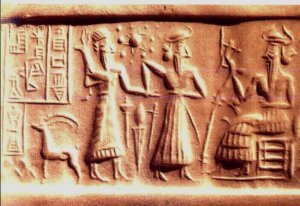
Sagan seemed to be particularly taken with the account of the amphibious teacher Oannes, who brought knowledge to the neolithic peoples of the Persian Gulf, given by Berosus. He goes on to offer a scenario of E.T. contact based upon long-term, intermittent ‘sampling’ expeditions to the Earth, the frequency of which increased as Mankind emerged (6). Sagan was considering these possibilities back in the 1960’s, and may well have come to similar conclusions to Zecharia Sitchin. If he did, he did not discuss them in public. But to have extolled the virtues of ancient astronaut hypothesis would surely have set his scientific career back significantly.
Sagan was clearly open to the idea that extra-terrestrials had visited our world in the past, and were contactable. This frame of reference may account for his inclusion on the Voyager team, particularly with regard to the communiques to ET intelligence carried by the probes. The plaque ‘bearing representational and symbolic information about the human race’ on Pioneer 10 appears to have been the brain-child of Richard Hoagland and Eric Burgess in 1971, who then passed the idea on to Carl Sagan (7)
2017 Update: Donald Zygutis has published a book about Carl Sagan which sets out the scientist's early fondness for ancient astronaut theories:
'The Sagan Conspiracy' by Donald Zygutis
The Golden Phonographs
It is an intriguing thought that either Voyager 1 or 2 could find itself coming across a hidden planetary system in our own comet cloud beyond Neptune.

One wonders what the Anunnaki would make of this probe, with its ET- friendly plaque designed by Dr Carl Sagan. Here he describes its content:
“Accordingly, as each Voyager left Earth for the planets and the stars, it carried with it a golden phonograph record encased in a golden, mirrored jacket containing, among other things: greetings in 59 human languages and one whale language…116 encoded pictures, on our science, our civilisation, and ourselves; and 90 minutes of the worlds greatest hits…” (8)
For instance, it has been pointed out that the first language listed among the 55 languages used on the Voyager phonograph, to offer galactic greetings to the occupants of an intercepting spaceship, is nothing less than Sumerian (9). True, it is the first known written language of our species, but why bother to include it at all? It has not been used for thousands of years. I suspect the same message written in 55 languages on the Voyager phonograph would act as a ‘Rosetta Stone’, allowing the intercepting civilisation the opportunity to understand the world’s various languages. Of course, they would need to understand one of them already.
The inclusion of Sumerian as the first language
might be for this very reason, providing a lingual key to understanding
the modern human languages. This assumes that the Anunnaki would
intercept Voyager 1 as it heads inexorably towards Nibiru. They would
have to have first-hand knowledge of the Sumerian language, but this is
not an unreasonable assumption given their alleged gift of knowledge to
this first civilisation on Earth.
Another interesting inclusion among Voyager 1’s ‘gift to the gods’ is the photograph from space of Egypt, the Nile and the Sinai Peninsula, courtesy of NASA (10). Given the importance of this geographical area to the Anunnaki, then this inclusion seems remarkably coincidental. Sitchin has often described the Sinai Peninsula as the area used for the Anunnaki’s rocketry, and the monuments in Egypt as artificial mountains designed to help pin-point the approach to this area from space.
Therefore, of all the parts of Earth, this is by far the most important to the space-faring Anunnaki. Perhaps this is simply a coincidence. Nevertheless, if the Voyager 1 mission were to include such data on purpose, then it was built up upon the Sumerian textual material, recognised by Sagan as important back in the 60’s. Again, this photo has been included among many randomly chosen images from the Earth, a tactic presumably used to conceal the importance of this choice among commentators on Earth.
Planetary Data System
Holger Isenberg has pointed out the depiction of a fiery red comet on one of NASA’s logos (11). This logo, for the Planetary Data System, shows a stylistic backdrop of planets amongst which is this anomalous red comet. It has a planet-sized disc, and would certainly appear to be a rather odd-looking comet.
Now, one could simply put this down to artistic licence by the designer of the emblem, but the above information about Sagan and Voyager tends to put it in a different context.
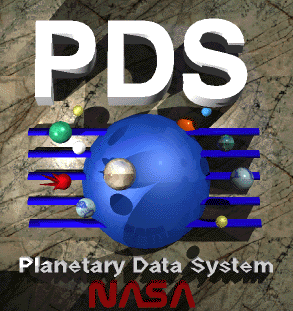
The number of planets depicted on the emblem is 11, including the red comet-like planet. Applying the pantheon of planets described by the Sumerians, we have the 9 planets of the Solar System, Earth’s moon and the red comet.
The Sun in the back-drop makes the total up to 12. Since we already know that Nibiru is red, and has a cometary orbit, then this depiction becomes readily understandable. The logo, itself, gives the impression of a modern design version of the famous Sumerian cylinder seal showing the planets of the Solar System.
Even the order of the planets around the
Sun seems in approximate accord, and one wonders whether the
designer of the logo had this image in
mind.
Contact
Carl Sagan was, of course, the author of the best-selling science fiction novel, ‘Contact’, and was made into a successful motion picture by Warner Brothers, starring Jodie Foster. The story involved SETI’s (Search for Extra-terrestrial Intelligence) monitoring of radio bandwidths for intelligent signals from space. A signal is picked up from Vega (in the direction of the Solar Apex), and leads to the realisation that we are not alone. The novel takes on a spiritual dimension towards the end, not unlike ‘2001: A Space Odyssey’ by Arthur C. Clarke.
Sagan’s novel contains many quotes and references from ancient texts. There are multiple references to different religious ideas and traditions, even UFO’s, but there is an under-current regarding the importance of Babylon. One of the central characters, Mr Hadden, is almost obsessive about the ancient Mesopotamian religion of the Chaldeans, and has this to say about Vega in the context of Gilgamesh’s quest for immortal life:
“It’s at the very top of the Ziggurat, you know, that the kings would go to receive instruction from the gods. Especially from Anu, the sky god. By the way, I looked up what they called Vega. It was Tiranna, the Life of Heaven. It’s a funny thing to call it.’” (12)
Why is it a ‘funny thing to call it’? Presumably because of the discovery of life in the Vega system made in the novel. But is this a hint about prior knowledge held by the Chaldeans? In the context of the ‘Epic of Gilgamesh’, this analogy becomes more important still. Was Gilgamesh seeking the ‘Life of Heaven’ in the direction of the star Vega, close to the Solar Apex and the aphelion location of Nibiru? The general interpretation of the ‘Epic of Gilgamesh’ is that it describes a terrestrial journey to a far-off land where Gilgamesh encounters the hero of the Flood, Utnapishtim, in the ‘Land of the Living’ (13). We will look at this myth in more detail next chapter, but Sagan has given us a tantalizing link between Vega and the ‘Land of Heaven.’ That is not all.
Towards the end of ‘Contact’, the cryogenically frozen Mr Hadden sets off in a ‘flying sarcophagus’ towards inter-stellar space. This auxiliary space vehicle acts as his mobile tomb and is called Gilgamesh! Sagan does not describe its actual destination, but the received message from Vega may be a clue to Sagan’s direction with this idea. Where else would Hadden choose, after all? Vega is the only star where life had been confirmed to exist. Remarkably, Hadden’s thought processes involved interception by extra-terrestrials ‘between the stars’, who would then ‘resurrect’ him from his cryogenic sleep:
“Or his funeral bark would be intercepted in the darkness between the stars, and other beings – very advanced, very far-seeing – would take the sarcophagus aboard and know what had to be done.” (12)
So Sagan is describing a ‘flying sarcophagus’
called ‘Gilgamesh’, presumably heading towards Vega, that is to be intercepted
by ‘far-seeing’ extra-terrestrials located ‘in the darkness between the
stars’. This then creates the physical conditions for ‘Resurrection’.

It
is also interesting to note that Sagan is seen photographed in front of
a“Winged Planet” motif on the inside cover of the hard-back version of
“Contact” (14). Why would Sagan wish to be associated with ancient
symbolism in this way, especially in a book concerning the first contact
with an extra-terrestrial race? Again, this appears to be a symbolic
hint at his understanding of ancient mythology, an interest which he dared
not reveal overtly, given the general bias against such ‘heretical’ knowledge
in the scientific community at large. There are many ways to put a message
across. Scientists in the public eye are careful not to succumb to
the temptation to speculate wildly.
In the author’s note to ‘Contact’, Sagan pays tribute, among other, to the late I. S. Shklovskii, with whom he co-wrote ‘Intelligent Life in the Universe’ in 1966 (5). He has come full circle. He also notes that the idea for ‘Contact’ had been developed with his wife, Ann Druyan, as early as 1980-81, preceding their book ‘Comet’. When this fictional work is put in context with Sagan’s involvement with the Voyager mission, his ‘Death Star’ theory about an hypothetical correlation between ancient myth and the potential existence of a brown dwarf in the Oort cloud, and his early writings about the Sumerian cylinder seals, then we can see a definite pattern emerging.
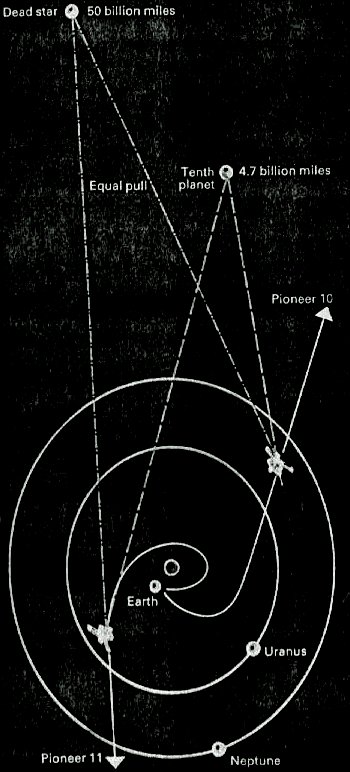 (15)
(15)
Dr Sagan may well have considered many of the ideas in this book as early as the 1960’s! His wonderful ability to communicate knowledge was put to good use, and the sub-text is clear. Our extra-terrestrial origins lie toward the Solar Apex in the Oort comet cloud.
Update May 2006: Voyager 2 Discovers a New Anomaly
The shape of the heliopause at the edge of the solar system has an unexpected distortion. This has been discovered by the Voyager 2 spacecraft, which has encountered the heliopause 76 Astronomical Units away, much closer than expected. The implication is that the heliopause itself is grossly distorted. Voyager 2 is heading out of the solar system at an inclination of 48 degrees to the ecliptic, into the Southern celestial hemisphere. It seems probable to me that this distortion has something to do with the Dark Star. In which case, we may be coming closer to a realisation of its position in the sky. If so, it's not in the direction I personally had expected, but that counts for very little.
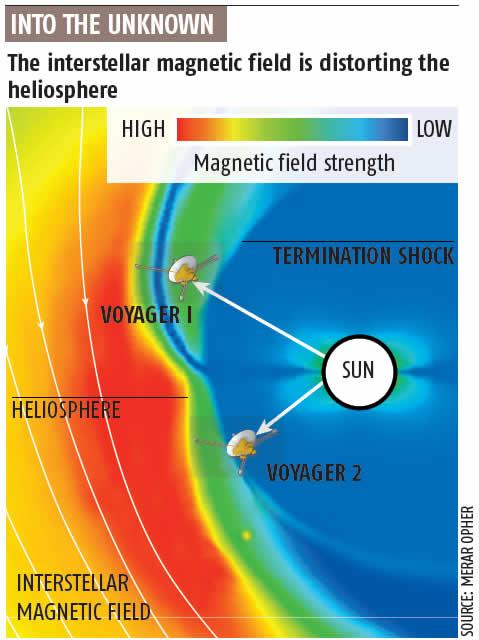
The point is that we may be very close now to the discovery of the Sun's binary companion.
"The outer boundary of the solar system is distorted as though it has been punched from below. The evidence comes from NASA's Voyager 2 spacecraft, which is about to cross the inner boundary even though it is closer to the sun than its twin spacecraft was when it crossed in 2004...Voyager 2 is 1.3 billion kilometres closer to the sun than Voyager 1 was when it crossed the shock in the northern hemisphere in December 2004 (New Scientist, 28 May 2005, p 15). This suggests the termination shock has been deflected inward in the southern hemisphere. " (16)
Scientific researchers analysing the data sent back from Voyagers 1 and 2 consider this anomaly to be due to interstellar magnetic fields. Although extremely weak, they might be extensive enough to provide this large, and unexpected, discrepancy they argue. Is this clutching at straws to explain such a large anomaly? One might argue that if the interstellar magnetic field was really capable of causing this large an effect, then the scientists would have been able to predict it prior to the data returns?
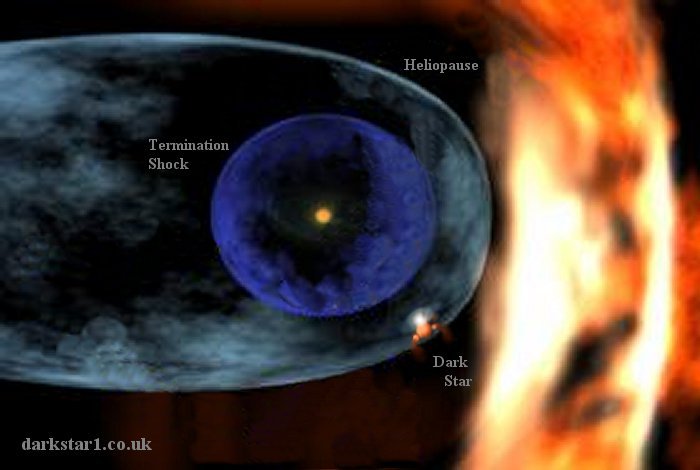
No, this is an unexpected discovery, and leads one to suspect an unexpected cause. The presence of the magnetic field of a binary solar companion seems a very plausible explanation. It is a pity that there are only 4 data points potentially available to map the heliopause; the two Voyager spacecraft, and the two Pioneers. Many will recall that the Pioneer spacecraft have been progressively slowing down; another unexpected event. They are following the plane of the ecliptic as the exit the solar system. The same effect does not seem to have been noted with the Voyagers. Maybe in the case of Voyager 2 it is because the spacecraft is heading towards a Dark Star?
Here's part of the transcript in the NASA podcast discussing the Voyager data:
Narrator: And I'm going to ask you more about what you think you, what you hope to learn once they cross into interstellar space, but I did want to mention the American Geophysical Union meeting, the May meeting, in Baltimore, you have some news about Voyager, can you sort of sum up what the news is that you're talking to your colleagues about?
Stone: Well the heliosphere is a comet shaped object, which means it has a blunt nose and it turns out that Voyager 1 is in the northern hemisphere of that blunt nose, and Voyager 2 is in the southern hemisphere. The big surprise is that Voyager 2 has found that the shock, where the wind slows down, is about nine astronomical units, about 900 million miles closer to the sun than it is in the north. That is, the front nose of the heliosphere is actually pushed in, in the south, by evidently an interstellar magnetic field which is pressing against it preferentially in the south. And that's the reason Voyager 2 may also reach interstellar space sooner than we expected because we now believe this blunt object is actually distorted by an interstellar magnetic field that's outside.
Narrator: Which sort of gets back to something I mentioned a few minutes ago, which is that there's not this nice, tidy boundary that tells you "You're now in our solar system" or you're not, correct?
Stone: That's right, it's not tidy at all because it's a fluid flow and there are pressures outside which deform it. Another thing which we've discovered is that the, with Voyager 1 which is now in this sheath region, we have found that the magnetic field there has potholes in it and it has bumps. That is that, unlike the supersonic wind, when the wind slows down it gets these potholes in the magnetic field where the field almost goes away and then it comes back and will be stronger than average. And so it's a very bumpy magnetic field in the heliosheath. (18)
But why? Surely the erratic nature of the heliosheath implies an interaction of some description.
Continue to
DarkStar6
Written by
Andy
Lloyd,
13th July 2000, and revised 18th April 2001 & 24th May 2006
author of 'The Dark Star'
(2005), 'Ezekiel One'
(2009), 'The Followers of
Horus' (2010) and 'Darker Stars' (2019) Published by Timeless Voyager Press
References
1) Carl Sagan & Ann Druyan “Comet” p300-306 Headline 1985
2) “Voyager’s Interstellar Mission”
3) B. Akins “Pioneer Home: Mission Status”
spaceprojects.arc.nasa.gov article
4) Correspondence from David Jinks 7th and 8th July 2000 . The transcription provided by Mr Jinks has proven invaluable to this investigation, for which I am very grateful.
5. Carl Sagan & I. S. Shklovskii “Intelligent Life in the Universe” p456-463 Holden-Day Inc. 1966
![]() Intelligent life in the universe
Intelligent life in the universe
6) Joan d’Arc “Space Travellers and the Genesis of the Human Form: Evidence of Intelligent Contact in the Solar System” pp144-145, The Book Tree 2000
![]() Space Travelers and the Genesis of the Human Form
Space Travelers and the Genesis of the Human Form
7) Lynn Picknett & Clive Prince “The Stargate Conspiracy: The Truth about Extraterrestrial life and the Mysteries of Ancient Egypt” p121 Warner 1999
8) C. Sagan “Pale Blue Dot: A Vision of the Human Future in Space” 392, 143-4, 152 Headline Book Publishing
9) JPL/NASA article no longer available online, with thanks to Rick Savard
10. 'Voyager Images' Thanks to Michael Weinberger
voyager.jpl.nasa.gov/galleries/
11. Correspondence from Holger Isenberg, 16th July 2000
12. Carl Sagan “Contact” p231, 397-9 Orbit 1996
13. N. Sandars (trans.) “The Epic of Gilgamesh: An English Translation with an Introduction by N.K. Sandars” Penguin 1960
14. Correspondence from Al Cornett, 20/7/2000
15. “How it works: The New Illustrated Science and Invention Encyclopaedia” Vol.18, page 2488, H.S. Stuttman Inc, © Marshall Cavendish Limited 1987
16. J. Marshall "The kink at the edge of the solar system" 24th May 2006 with thanks to Shad and Monika
17. K. Than "Voyager 2 Detects Odd Shape of Solar System's Edge" 23rd May 2006, Space.com with thanks to Brian Forsyth (no longer available online)
18. JPL/NASA Podcast no longer available with thanks to Mattia